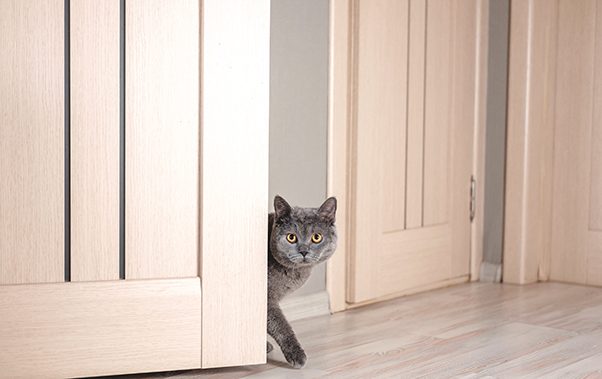We all know and love our cat’s independent nature, but sometimes you need them to come to you. You may be wondering how to get a cat to come to you, and especially how to get a cat to come home at night when they’re living their best life at dusk! Recall training can be a successful way to encourage your kitty to come back.
Whether it’s dinner time, night time or time for the vet, there are occasions when training your pet to recall is essential. And whilst it’s great that your cat is exploring independently, recall training is key to their safety and wellbeing.
Training your cat to recall won’t necessarily work every time, but practice makes perfect and your cat will usually learn to come to you using these simple tricks.
So, how to get a cat to come to you? Useful tips
Cats are all different, and different techniques for how to get a cat to come to you outside will work for different personalities, but it’s a vital skill for any cat - and pet owner - to master. The secret is consistency, patience and rewarding your cat for coming when you ask.
- Start indoors: Cat recall training is best to do before cat flap training, or before your cat is allowed to roam outside. Start indoors in a calm environment to minimise distractions, noise or stress. Make sure your cat is in a good mood before you begin!
- Use positive reinforcement: Cats are free-thinkers and won’t do anything they don’t want to do, so reward them using cat treats, praise and affection if they come. The best technique for how to get a cat to come out of hiding or exploring is to make it worth their while, so they feel happy, safe and loved when they reappear.
- Be patient and consistent: Cats have sensitive hearing, so big bellowing noise is likely to scare them away rather than recall them. Choose a noise or pitch of your voice that they like. Consistency is key to reinforcing their behaviour in a positive way. Make sure you stay calm and don’t raise your voice if your cat won’t respond.
Methods of getting a cat to come to you
Some cats respond to their name, a ‘cue word’, or when you use gentle squeaking or kissing sounds with your lips. Another cat’s attention might be better gained through clicking sounds, or the shaking sound of a packet of their favourite DREAMIES™ cat treats. You may need to use trial-and-error to find the best trick for how to get a cat to come to you.
Here are some tried and tested techniques for how to get a cat to come home or indoors when you call:
- Create positive associations: Think about what your cat enjoys. Is it being stroked in a certain way, playing their favourite game or enjoying their favourite food? Reward your cat for coming when you call by giving them a cat treat, some extra affection or play time with their best cat toy when they return. Positive experiences promote effective cat recall!
- Training with a clicker: Clicker training can be effective with many cats, but not all will respond and some may hate the sound. Test how your cat reacts to the noise. If it’s positive, choose a quiet, calm area and start by following each click with a treat or reward. Your cat will quickly associate the two together. Use your call word (or noise) and click, reward then repeat.
Of course, cats who are deaf or hard of hearing won’t respond to subtle sounds, but may respond to a pattern of vibrations on the floor. Hand signals can be mastered in a similar way - and for solutions on how to get a cat to come home at night - training using a flashing light might do the trick.

How to get a cat to come home
Understandably, it’s easier to learn how to get a cat to come out of hiding indoors than it is to master how to get a cat to come to you outside. However, cats have exceptional hearing and, by using a consistent routine, your cat may well come home of their own accord when it’s dinner time or when it gets dark. Practising cat recall training at the same time every day lets your cat know they need to come back at certain times. You should also:
- Provide comfort and security: By creating a safe, comfortable and cosy space for your cat to come home to, they’re less likely to want to stay outdoors. By keeping their environment calm at the time you want them to come back, they’re more likely to respond.
- Use scent cues: If your cat seems lost or is refusing to come in, a handy trick for how to get a cat to come home at night is to leave scent cues for them to follow. Rubbing their - or your - familiar scent on places leading back to the door can help guide them home.
- Microchip your pet: Cats can roam far from home, and it’s now a legal requirement in the UK to have your cat microchipped. Collars can also help, but some cats find them uncomfortable, and they are at risk of getting caught up in foliage or falling off.
- ALL IT TAKES IS A SHAKE™: Although some cats come when you call their name, a shake of their cat treats packet is a great solution for how to get a cat to come out of hiding, or come home if they’re out on an extended adventure. Remember to always reward them with a treat, or they’ll soon get wise to it!
What to do if a cat won’t come to you?
If you know your cat is safe and can hear you, give them some quiet time and space to come out on their own. You can also use cat recall training, and the sound of their cat treat bag to get their attention. It may be too noisy, they are distracted, afraid, far away, unwell or they may need to revisit their recall training. As all cat owners know, our furry friends have their own minds and won’t always come when they’re called, so:
- Assess the environment: If your cat isn’t responding, go and look for them to reassure them. They may also be lost or need assistance. Assess the surroundings and make sure it’s safe for them to come to you.
- Avoid punishment: If your cat is safe and well but doesn’t want to come, avoid shouting at them or punishing them. This will make them less likely to come to you in future. After all, their independent nature is why we love them. Try to keep their home environment a safe and calm place to return to.
- Revisit recall training techniques: It may be that your cat has conveniently forgotten their recall training, or something has changed in their routine. You can always gently revisit your original training method, offering plenty of praise as you go. It’s important to make training fun for your cat, to encourage them to cooperate, so make sure you give them extra affection and play with your cat as a reward.

Importance of building a strong bond with your cat
If a cat feels safe, loved and happy at home they will want to come back to you and their own area indoors as they’re highly territorial creatures. Choosing some fun games to play with your cat, rewarding them with treats and being consistent and positive in your cat recall training will help support their understanding.
Trust plays a large part in teaching how to get a cat to come to you outside, and it’s vital that you build a strong relationship before any training begins. This bond helps you to pick up on their cues, and they yours, so that you can understand one another and support your cat’s wellbeing. A stress-free feline, allowed to safely explore on their own, is a happy one - and building effective communication between you will help you both enjoy the benefits of being a cat parent!





